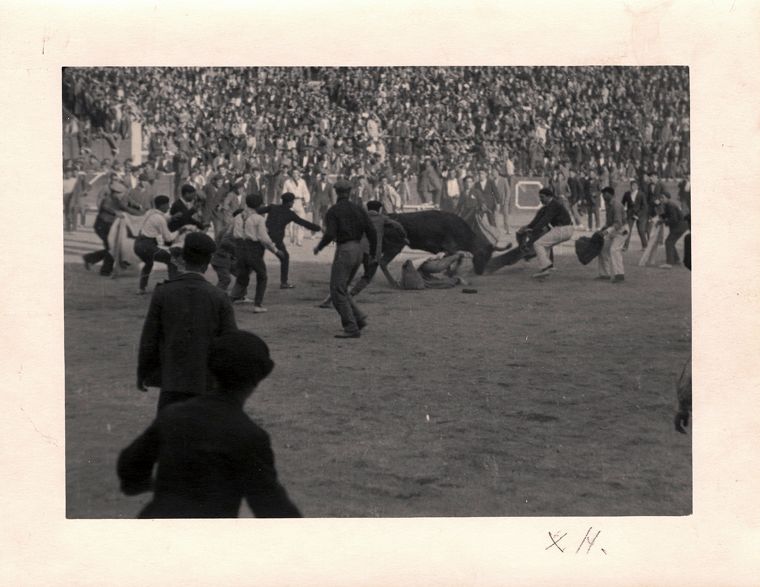
Hemingway participating in the Encierro, in Pamplona, in 1925--Hemingway is in front of the bull (Photograph from the Ernest Hemingway Collection, John F. Kennedy Presidential Library and Museum, Boston)
On July 6th, 1923, Ernest Hemingway and his wife Hadley arrived in Pamplona for the Fiesta of San Fermín but found the room they booked weeks beforehand had been given to others. So, for them, the fiesta began with Ernest making a mad scramble to find new accommodations, all while his heavily pregnant wife sat on her backpack on the floor of their intended hotel. In spite of this bad beginning, Hemingway became enamoured with Pamplona. His excitement is evident in what he wrote about the experience for the Toronto Star Weekly. In his article “World’s Series of Bull Fighting a Mad, Whirling Carnival,” Hemingway observed that “the streets were solid with people dancing. Music was pounding and throbbing. Fireworks were being set off from the big public square.”1
It was a thirst for more that had brought Hemingway to Pamplona. A little over a month earlier, in late May, after traveling from Paris to Madrid with Robert McAlmon, Hemingway became instantly hooked when he saw his first bullfight—was captivated by the pageantry and ceremony, and the battle with death. But as Hemingway commented in his article for the Star “Bull-Fighting Is Not a Sport – It Is a Tragedy,” his first published article about bullfighting, the bullfight he witnessed that day "was not the best. The best was in the little town of Pamplona high up in the hills of Navarre," that he saw weeks later.2
Hemingway’s love for Pamplona continued throughout his life and resulted in several visits. In July 2023, to mark the 100th anniversary of his first time in the city, a journalist interviewed one of the last living Pamplonians to have met Hemingway in person. 91-year-old Leontxi Arrieta recalled that her family hosted the writer and his fourth wife, Mary Welsh, on their last visit in 1959, in their home “where Hemingway wrote, drank vodka, and shocked the family by removing the crucifixes from the wall and putting them in the cupboard.”3
Hemingway made Pamplona and its annual festival central to his 1926 novel The Sun Also Rises, and Pamplona has since become synonymous with Hemingway-related tourism. Not everyone has been happy about that. Alice B. Toklas, who first recommended the Hemingways visit the town, later considered Pamplona forever ruined "on account of Hemingway."4 Even Hemingway worried about the impact he might have caused, writing in The Dangerous Summer the city was "all there, as it always was, except forty thousand tourists have been added."5
The increasing swell of tourists became the focus of a mock trial held on June 8, 2023, organized by the Navarre Writers Association. Accused of being the root cause of the commercialization and overcrowding at the San Fermín, Hemingway was tried at the peña Anaitasuna. A jury drawn by lottery from the audience would consider his fate, with a panel of expert witnesses (such as writers Miguel Izu and Idoia Saralegui) giving testimony.
Coming up in Part II – Learn what the jury concluded about Hemingway’s influence on Pamplona’s history and culture, and what an AI Hemingway had to say about the 2023 Fiesta of San Fermín.
Works Cited
Hemingway, Ernest. “Bull-Fighting Is Not a Sport – It Is a Tragedy,” The Toronto Star Weekly (Oct. 20, 1923) https://ehto.thestar.com/marks/bullfighting-is-not-a-sport-it-is-a-tragedy.
---. “World’s Series of Bull Fighting a Mad, Whirling Carnival,” Toronto Star Weekly (Oct. 27, 1923) rpt. as “Pamplona in July” in Ernest Hemingway Dateline: Toronto ed. William White (New York: Scribner, 1985), pp. 347-354.
“‘Juicio’ a Ernest Hemingway en la peña Anaitasuna sobre su papel en las fiestas,” Noticias de Navarra (June 8, 2023) https://www.noticiasdenavarra.com/pamplona/2023/06/08/juicio-ernest-hemingway-pena-anaitasuna-6907732.html.
Vera, Susana and David Latona. “A century on, Hemingway's prose lures revellers to Spain's Pamplona” (Reuters, July 12, 2023) https://www.reuters.com/investigates/special-report/spain-culture-bulls-hemingway/.
1 Hemingway, Ernest. “World’s Series of Bull Fighting a Mad, Whirling Carnival,” Toronto Star Weekly (Oct. 27, 1923) rpt. as “Pamplona in July” in Ernest Hemingway Dateline: Toronto ed. William White (New York: Scribner, 1985), pp. 347.
2 Hemingway, Ernest. “Bull-Fighting Is Not a Sport – It Is a Tragedy,” The Toronto Star Weekly (Oct. 20, 1923) https://ehto.thestar.com/marks/bullfighting-is-not-a-sport-it-is-a-tragedy.
3 Vera, Susana and David Latona. “A century on, Hemingway's prose lures revellers to Spain's Pamplona” (Reuters, July 12, 2023) https://www.reuters.com/investigates/special-report/spain-culture-bulls-hemingway/
4 Simon, Linda. The Biography of Alice B. Toklas. (Lincoln: University of Nebraska Press, 1991), p. 146.
5 Hemingway, Ernest. The Dangerous Summer. (New York: Scribner, 1985), p. 136.
Sharon Hamilton is a member of the Hemingway Society Board. She has blogged previously for the Hemingway Society about visiting Hemingway and Hadley’s Chicago Apartment and about Hemingway’s New Orleans.
John Hargrove is a Michigan-based writer and Hemingway researcher; he is also the founder of "Ernest Hemingway: The True Gen," an online community of Hemingway researchers and aficionados hosted on social media.